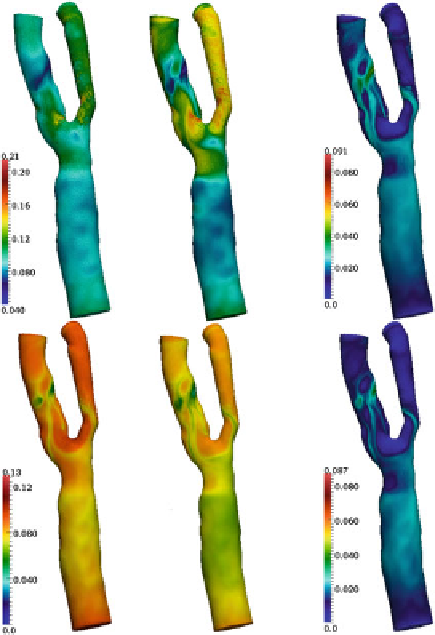Biomedical Engineering Reference
In-Depth Information
Fig. 2
Upper row
Distribution on the arterial
surface of [ATP] (
µ
M) during
a
systole
b
diastole and
[ADP] (
(a)
(b)
(c)
µ
M) during
c
diastole. ATP production at
the endothelium depends on
wall shear stress only.
Lower
row
Distribution on the
arterial surface of [ATP]
(
M) during
d
systole,
e
diastole and [ADP] (
µ
µ
M)
during
f
diastole. ATP
production at the endothelium
depends on wall shear stress
and time. The figure is taken
from [
38
]
(d)
(e)
(f)
nucleotides as the agonist (mostly adenosine-5' triphosphate ATP and adenosine
diphosphate ADP), many researchers have tried to characterise flow regulation of
ATP- and ADP-
Ca
2
+
coupling in the concentration boundary-layer, and the effect
of enzymatic degradation at the endothelium [
29
-
37
]. Small changes in the model
parameters, such as the rate constants for convection of ATP from the bulk fluid to
the cell surface or for the degradation and/or production of ATP significantly influ-
ence the pattern of catalytic reactions at the endothelium [
38
]. As we have shown
earlier, and as illustrated in Fig.
2
, even though the bulk concentration of secreted
agonists is low and mostly unaffected by the flow, variations exist at the endothe-
lium, which are nevertheless difficult to quantify numerically. Higher concentration
of agonists, and the existence of steep gradients in the boundary layer will be affected
by changes in the flow field, potentially generating further signalling cascades. Such
propagated effects might constitute elements of an intravascular axis that serves to
regulate vascular tone [
38
-
42
]. See also the review by Davies on endothelial mechan-
otransduction [
43
].


